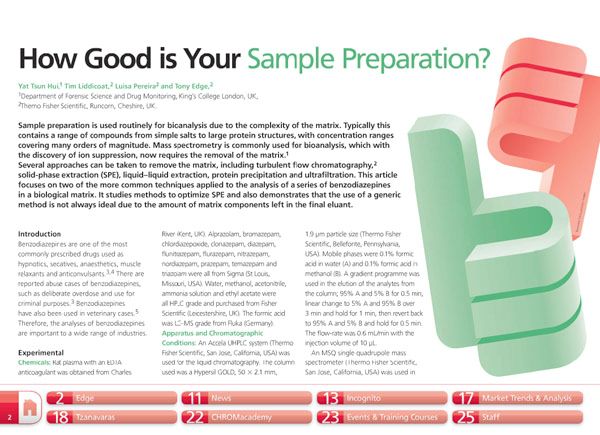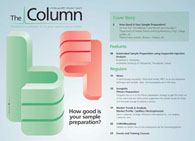How Good is Your Sample Preparation?
This article focuses on two of the more common techniques applied to the analysis of a series of benzodiazepines in a biological matrix.
Sample preparation is used routinely for bioanalysis due to the complexity of the matrix. Typically this contains a range of compounds from simple salts to large protein structures, with concentration ranges covering many orders of magnitude. Mass spectrometry is commonly used for bioanalysis, which with the discovery of ion suppression, now requires the removal of the matrix.
Several approaches can be taken to remove the matrix, including turbulent flow chromatography, solid-phase extraction (SPE), liquid–liquid extraction, protein precipitation and ultrafiltration. This article focuses on two of the more common techniques applied to the analysis of a series of benzodiazepines in a biological matrix. It studies methods to optimize SPE and also demonstrates that the use of a generic method is not always ideal due to the amount of matrix components left in the final eluant.
Study Explores Thin-Film Extraction of Biogenic Amines via HPLC-MS/MS
March 27th 2025Scientists from Tabriz University and the University of Tabriz explored cellulose acetate-UiO-66-COOH as an affordable coating sorbent for thin film extraction of biogenic amines from cheese and alcohol-free beverages using HPLC-MS/MS.
Quantifying Microplastics in Meconium Samples Using Pyrolysis–GC-MS
March 26th 2025Using pyrolysis-gas chromatography and mass spectrometry, scientists from Fudan University and the Putuo District Center for Disease Control and Prevention detected and quantified microplastics in newborn stool samples.
Multi-Step Preparative LC–MS Workflow for Peptide Purification
March 21st 2025This article introduces a multi-step preparative purification workflow for synthetic peptides using liquid chromatography–mass spectrometry (LC–MS). The process involves optimizing separation conditions, scaling-up, fractionating, and confirming purity and recovery, using a single LC–MS system. High purity and recovery rates for synthetic peptides such as parathormone (PTH) are achieved. The method allows efficient purification and accurate confirmation of peptide synthesis and is suitable for handling complex preparative purification tasks.










